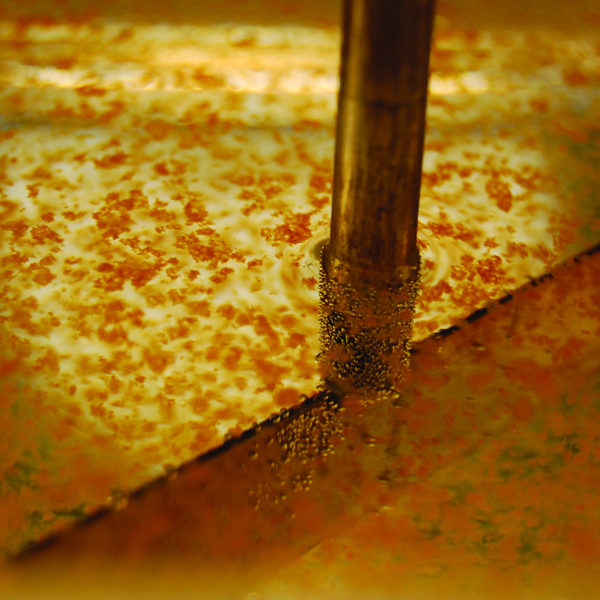An innovative process established at Fraunhofer IGB is electrophysical precipitation (EpF). Here the water to be treated is passed through a reactor, in which an electric current flows through sacrificial electrodes. This results in electrochemical reactions; the sacrificial electrodes dissolve, releasing their metal ions. Besides the metal ions, which destabilize particles, metal hydroxide flocs are produced in the process. These electrolytically generated metal hydroxide flocs have a high adsorption capability and can thus bind to finely dispersed particles. In addition, there are coprecipitation and occlusion precipitation reactions, in which dissolved organic and inorganic substances are precipitated. The precipitated substances can then be separated mechanically.
Electrophysical precipitation and coagulation with sacrificial anodes
Our development

Electrophysical precipitation replaces conventional chemical flocculation techniques with the advantage that the flocculants are made available electrolytically from solid state electrodes where they are required in dissolved molecular form. Iron or aluminium can be used as electrode material; these are inexpensive, readily available, and easy to handle. The metal ion is specifically added only to the water to be treated; an increase in the salt content does not occur. Using this process there are no costs for the purchase, handling, or the dispersal of flocculants and flocculating additives.
Advantages
Electrolytic and oxidative processes offer economically attractive and sustainable solutions for the purification of industrial, process waters, and wastewaters. They are a good alternative for substances that cannot be broken down conventionally or that are only degradable at great expense. The energy required for operating the system can be provided by electricity from renewable sources such as solar and wind power.
- No increase of salinity – recirculation possible
- No disinfection by-products – in particular no halogenated compounds
- No or little sludge formed
- Perfectly hygienic outflow water
- Robust process – discharge criteria can be met safely, reliably and lastingly
- Available quickly – standby operation possible
- Suitable for varying quantities of wastewater and pollutant load
- Minimal maintenance – staff savings and increased reliability
R&D services
- Development of the plant technology including automation through to the industrial prototype, working together with industrial partners
- Process optimization, also for higher-viscosity media, for example cooling lubricants, foodstuffs, sludges and pastes
- Combination with processes for the desalination or recovery of acids and bases
Applications
Emulsion splitting
The EpF process is also especially suited for the splitting of stable emulsions, for example drilling and cutting oil emulsions or wastewater from washing processes, which is otherwise frequently effected by adding demulsifiers. Separating emulsions with membranes, particularly by ultrafitration, does create a recyclable permeate but the costs for acquisition and running are high. In thermal processes, the aqueous phase is evaporated and the oil phase is retained as a concentrate but here the energy demands are extremely high. Metallic salts such as FeCl3 are used to separate solids from suspensions, and are responsible for oversalinating water. It is imperative to dose polymers exactly since overdosing makes them act as emulsifers. Electro-physical precipitation is an alternative innovative process for separating stable emulsions and suspensions without having to add chemicals.
Halving the treatment costs for paper wastewater
For a paper manufacturer we optimized the plant for purification of the process wastewater and increased its capacity. We replaced conventional flocculation with a plant on the principle of electro-physical precipitation. By saving chemicals such as flocculants, polyelectrolytes and caustic soda it was possible to reduce the costs for the wastewater treatment by half.
Removal of finely suspended substances from paint wastewater
In a feasibility study for an aircraft manufacturer we successfully treated paint wastewater from the painting systems by means of electro-physical precipitation. The clouding of the wastewater was reduced by 95 percent, the COD (chemical oxygen demand) value by 75 percent. Similar studies were carried out for paint manufacturers. Here too, we were able to show that it was possible to reduce the clouding, the COD value and the smell significantly.
 Fraunhofer Institute for Interfacial Engineering and Biotechnology IGB
Fraunhofer Institute for Interfacial Engineering and Biotechnology IGB